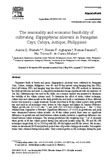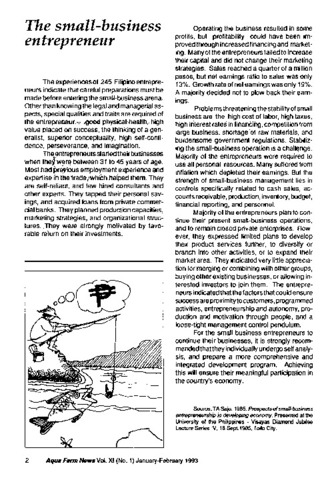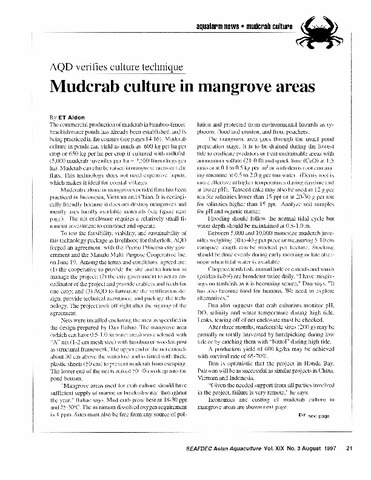The seasonality and economic feasibility of cultivating Kappaphycus alvarezii in Panagatan Cays, Caluya, Antique, Philippines
- Global styles
- MLA
- Vancouver
- Elsevier - Harvard
- APA
- Help
Share
Abstract
Vegetative thalli of brown and green Kappaphycus alvarezii were cultivated in Panagatan Cays, Caluya, Antique, Philippines, over 60- and 90-day periods using hanging-long line (HL), fixed off-bottom (FB), and hanging long line–fixed off-bottom (HL–FB) methods to determine the daily growth rate and yield. A completely randomized design experiment with six replicates of 5-m line cultivation rope was used in the study. An economic analysis was prepared to determine the viability of the culture systems used. To determine the effect of strain, culture technique, culture days and culture month on the daily growth rate and yield, a combination of these different factors was treated as a single treatment. Results show that at 60-day culture period, daily growth rate and yield in all techniques were lowest in July–August and highest in January–February. Higher growth rate (2.3–4.2% day−1) and yield (3.6–15.8 fresh weight kg m−1 line−1) were obtained from September to February. Significant differences (P<0.05) in growth rate and yield were determined between culture months. At 90-day culture period, there were no significant differences in growth rate and yield between culture months; however, a significant difference was found between culture techniques. The average production (dry weight kg crop−1) of K. alvarezii when grown at 60-day culture period during lean and peak months using HL, FB and HL–FB techniques ranged from 421 to 3310 kg with HL–FB the highest and FB the lowest. Net income, return on investment (ROI) and payback period were all positive during peak months, but negative values were obtained during lean months. Only seaweed grown on HL technique during the peak months at 90-day culture period showed positive income, ROI and payback period. The seasonality of cultivating K. alvarezii is shown in this present study. This paper further shows the best culture technique to be adopted at certain months of the year to produce the highest yield and income.
Suggested Citation
Hurtado, A. Q., Agbayani, R. F., Sanares, R., & de Castro-Mallare, M. T. R. (2001). The seasonality and economic feasibility of cultivating Kappaphycus alvarezii in Panagatan Cays, Caluya, Antique, Philippines. Aquaculture , 199(3-4), 295-310. https://doi.org/10.1016/S0044-8486(00)00553-6
Type
ArticleISSN
0044-8486Koleksi
- Journal Articles [1258]
Related items
Showing items related by title, author, creator and subject.
-
The small-business entrepreneur
Castaños, Milagros T.; Southeast Asian Fisheries Development Center, Aquaculture Department (Aquaculture Department, Southeast Asian Fisheries Development Center, 1993) -
Mudcrab culture in mangrove areas: AQD verifies culture technique
Aldon, Eva T. (Aquaculture Department, Southeast Asian Fisheries Development Center, 1997) -
Series: Aquaculture extension manual; No. 34
Biology and hatchery of mud crabs Scylla spp.
Quinitio, Emilia T. ; Parado-Estepa, Fe Dolores (Aquaculture Department, Southeast Asian Fisheries Development Center, 2008)
This manual includes the biology of mud crab, and describes principles and procedures for spawning the mature crabs (Scylla serrata, S. tranquebarica, and S. olivacea) and rearing the zoea to fly size crabs. It focuses on ...
; Parado-Estepa, Fe Dolores (Aquaculture Department, Southeast Asian Fisheries Development Center, 2008)
This manual includes the biology of mud crab, and describes principles and procedures for spawning the mature crabs (Scylla serrata, S. tranquebarica, and S. olivacea) and rearing the zoea to fly size crabs. It focuses on ...





